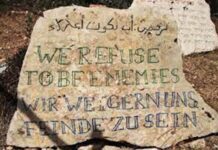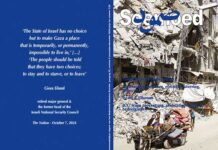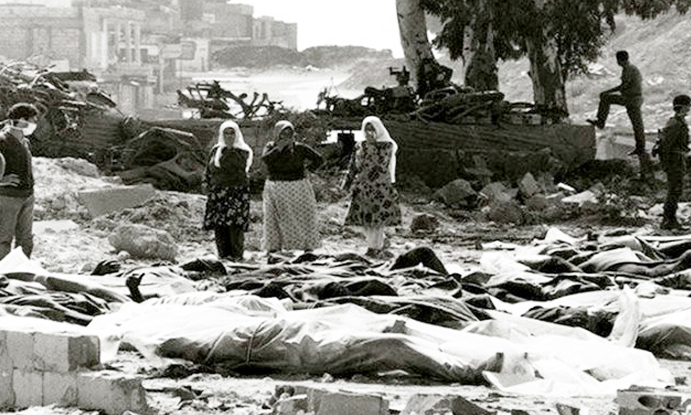een van de dieptepunten in de grote campagne van etnische zuivering van Palestina
Dit jaar is het 71 jaar geleden dat de massamoord in Deir Yassin plaatsvond. Deze is uitgevoerd door strijders van de joods-zionistische terroristische Irgoen-militie – met medeweten, dan wel indirecte steun van reguliere joods-zionistische gevechtseenheden.
In onderstaand artikel van Hal Draper dat dateert uit 1956 (ruim 60 jaar geleden), dat zich in belangrijke mate op joods-zionistische en mainstream bronnen baseert, blijkt dat destijds al in grote mate de omvang bekend was van het drama dat zich van 8-9 april 1948 in Deir Yassin heeft voltrokken.
Bij het bloedbad zijn ten minste 110-120 Palestijnse burgers afgeslacht. Gevangengenomen overlevenden werden vervolgens in vrachtauto’s naar Jeruzalem gebracht om daar in een soort overwinningsparade door de joodse wijken aan de bevolking getoond te worden. Daarna zijn van de gevangenen ongeveer 25 volwassen mannen teruggebracht naar Deir Yassin, waar zij in een steengroeve met geweren en mitrailleurs zijn afgeslacht. 53 kinderen werden wees. Zij zijn nadien ondergebracht in het door mevrouw Hind al-Husseini speciaal voor hen opgerichte Dar al-Tifl al-Arabi-weeshuis in Deir Yassin.
Het bloedbad in Deir Yassin zou een van de openingszetten zijn in grote campagne van etnische zuivering van Palestina door joods-zionistische strijdgroepen. Voor deze oorlogsmisdaad is nooit iemand ter verantwoording geroepen. De toenmalige leider van Irgoen, Menachem Begin, zou van 1977-1983 premier van Israel zijn. Voordat hij als premier terugtrad, was hij in 1982 nog verantwoordelijk voor de zeer bloedige en verwoestende oorlog tegen Libanon, die tot doel had de Palestijnse Bevrijdingsorganisatie (PLO) te vernietigen.
Bij het bloedbad zijn ten minste 110-120 Palestijnse burgers afgeslacht. Gevangengenomen overlevenden werden vervolgens in vrachtauto’s naar Jeruzalem gebracht om daar in een soort overwinningsparade door de joodse wijken aan de bevolking getoond te worden. Daarna zijn van de gevangenen ongeveer 25 volwassen mannen teruggebracht naar Deir Yassin, waar zij in een steengroeve met geweren en mitrailleurs zijn afgeslacht. 53 kinderen werden wees. Zij zijn nadien ondergebracht in het door mevrouw Hind al-Husseini speciaal voor hen opgerichte Dar al-Tifl al-Arabi-weeshuis in Deir Yassin.
Het bloedbad in Deir Yassin zou een van de openingszetten zijn in grote campagne van etnische zuivering van Palestina door joods-zionistische strijdgroepen. Voor deze oorlogsmisdaad is nooit iemand ter verantwoording geroepen. De toenmalige leider van Irgoen, Menachem Begin, zou van 1977-1983 premier van Israel zijn. Voordat hij als premier terugtrad, was hij in 1982 nog verantwoordelijk voor de zeer bloedige en verwoestende oorlog tegen Libanon, die tot doel had de Palestijnse Bevrijdingsorganisatie (PLO) te vernietigen.
—————————
On the Deir Yassin Massacre Anniversary (April 8-9, 1948)
David Finkel
Solidarity / April 8, 2019
The Israeli elections on April 9, 2019 will coincide with the anniversary of the massacre of the Arab village of Deir Yassin, a turning point in the mass flight of Palestinians during the 1948 war (the Nakba, or catastrophe). According to establishment historiography, this massacre was carried out by the extreme right-wing Irgun militia — the military arm of the party that gave rise to today’s governing Likud — but the truth is more complicated to say the least.
The village of Deir Yassin was defended lightly, if at all, and had no record of insurgency. That’s why it was chosen for the Irgun’s attack:
Deir Yassin resounded throughout the land, indeed throughout the world, and with the desired effect. Even a record of friendship for the Jews was no protection, no insurance. It was after this that the Arab flight became general.
This quote is from a lengthy article by Hal Draper, Israel’s Arab Minority: The Beginning of a Tragedy. The entire piece is worth reading, among other reasons because it shows how much information was actually available, from strictly Zionist and mainstream sources, more than six decades ago. Sections 7 through 11 of the essay deal specifically with the Deir Yassin, the story behind the massacre, and its consequences.
As Draper writes:
The official Zionist army, Haganah, repudiated the massacre, undoubtedly sincerely, but also went on to claim that the Irgun had attacked Deir Yassin without any military justification and without the agreement of the official forces. The Irgun countered by releasing the exact text of the letter from the regional Haganah commander agreeing to the attack (not to a massacre, of course)…but [Deir Yassin] was supposed to be assaulted and invested as a military operation, in cynical violation of any non-aggression obligation to it.
So there was direct “official-Zionist” complicity. During the attack itself, “among the obscure relations is undoubtedly the role of the other official-Zionist armed force, the Palmach,” which was close by and provided covering fire to assist wounded Irgunists.
It is not easy to see what, according to the official story, the Palmach was doing there in the first place. So it is not quite true that the Deir Yassin massacre was simply the uncontrollable act of mavericks for whom the official Zionists were not responsible, as it is represented by all good Zionist writers who duly express their horror at it.
Subsequently, far from a rupture between the “official” Haganah and “maverick” Irgun, relations became closer. As for the Haganah and official Zionist leadership, “It was not Arab-exterminationism which moved them to break with the terrorists; it was the assassination five months later of the UN mediator, Count Bernadotte” (a murder carried out by an extreme Zionist-terrorist faction called “Sternists”).
This is one revealing fragment of the Nakba story. Read it and weep.













